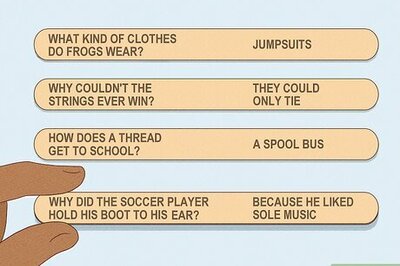
views
Salmon, Idaho: They work as doctors and lawyers by day but lurk as vampires by night. While they may not wish to suck your blood, there are plenty of willing victims on tap, according to a top US scholar on a subculture that emulates the undead.
Idaho State University sociologist DJ Williams, newly hired as a consultant for a proposed television documentary about "self-identified vampires," said true modern acolytes of Dracula seek consensual blood-sharing relationships.
The popular fascination with vampires dates back to the 1897 publication of Bram Stoker's 'Dracula', and later books such as Anne Rice's 'The Vampire Chronicles.'
But it exploded in recent years with the best-selling 'Twilight' series of novels by Stephenie Meyer and movie adaptations. The seductive vampire character Edward Cullen in the movie, played by actor Robert Pattinson, became a teen idol and made vampires cool.
VAMPIRE MANIA
Vampire mania has spawned an international subculture that strongly relates to traits associated with mythical vampires. They are believed to be seductive beings unafraid to explore the dark side of human nature that is usually masked for the sake of social acceptance.
"Self-identified vampires realize humans are a mix of light and dark," said Williams. "There is the socially desirable self that people show in public and then there is the shadow self that may not be as nice, not as optimistic. It varies from person to person, but generally vampires don't pretend it's not there: they acknowledge it and try to manage it."
What separates them from mere vampire wannabes -- the guy in a cape who sleeps in coffins or believes he is capable of morphing into a bat -- is an internal lack of energy that makes them seek energy from external sources such as the high that comes from the crowd at a rock concert or from the blood of a willing donor.
"They call it feeding," said Williams, who also moonlights as an FBI consultant for investigations involving violent criminals who are claiming to be vampires.
SUCKING BLOOD
Williams says self-identified vampires seek significant others with an abundance of energy willing to allow them to suck blood from a small incision made high up on the chest by a scalpel.
"Quite often, they are in a relationship with a donor, where one person has energy blockages and the partner has excess energy; it's a perfect, symbiotic relationship," he said.
The arrangement is legal because it is struck between two consenting adults and aims to have no ill effect, said Williams.
He is pioneering the study of such alternative lifestyles. It took years for the scholar in forensic social work, criminal justice and leisure sciences to gain the trust of self-identifying vampires, whom he says are widely misunderstood.
"The negative discourse out there about blood and the transmission of infectious diseases just drives them underground," said Williams, who advises vampire acquaintances to abide by safe blood-drinking practices like having donors tested for HIV and other ailments transmitted by blood.
And with American serial killers such as Jeffrey Dahmer, who killed 17 young men and boys in a frenzy of necrophilia and cannibalism between 1978 and 1991, billing himself as a vampire, what's a law-abiding vampire to do?
"The vampire community would argue that Jeffrey Dahmer and others aren't real vampires, they're murderous criminals," Williams said. "Those high-profile cases damage the image of self-identified vampires."
Vampire myths span the centuries, with some pinned to real-life figures like Vlad the Impaler, a 15th-century Romanian noble known for the fearsome punishment he inflicted on enemies.
MOST ADMIRED MONSTERS
Pointing to a UCLA study that ranked vampires as the most admired of monsters, Williams said self-identified vampires wage an uphill battle with stereotyping.
The subculture sometimes sinks its teeth into debates about proper vampire attire and etiquette, with some clans requiring black clothing and others insisting on beverages like blood.
Surveys circulating among vampires ask questions about their energy level, whether they heal quickly from wounds and whether blood bothers them.
Williams said virtually every age, race, religion and profession is represented in the subculture, which is strongest in urban areas.
"They see themselves as normal, regular people in normal regular jobs: they are teachers, lawyers, accountants, they may be parents," he said. "They have normal lives but there is this aspect to needing to take energy from time to time and in certain ways."















Comments
0 comment